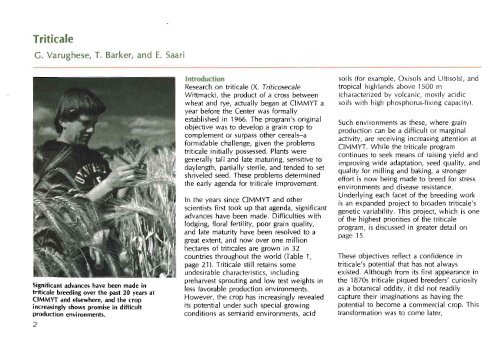U - Search CIMMYT repository
U - Search CIMMYT repository
U - Search CIMMYT repository
Create successful ePaper yourself
Turn your PDF publications into a flip-book with our unique Google optimized e-Paper software.
Triticale<br />
G. Varughese, T. Barker, and E. Saari<br />
Significant advances have been made in<br />
triticale breeding over the past 20 years at<br />
C1MMYT and elsewhere, and the crop<br />
increasingly shows promise in difficult<br />
production environments.<br />
2<br />
Introduction<br />
Research on triticale (X. Triticosecale<br />
Wittmack), the product of a cross between<br />
wheat and rye, actually began at C1MMYT a<br />
year before the Center was formally<br />
established in 1966. The program's original<br />
objective was to develop a grain crop to<br />
complement or surpass other cereals-a<br />
formidable challenge, given the problems<br />
triticale initially possessed. Plants were<br />
generally tall and late maturing, sensitive to<br />
daylength, partially sterile, and tended to set<br />
shriveled seed. These problems determined<br />
the early agenda for triticale improvement.<br />
In the years since <strong>CIMMYT</strong> and other<br />
scientists first took up that agenda, significant<br />
advances have been made. Difficulties with<br />
lodging, floral fertility, poor grain quality,<br />
and late maturity have been resolved to a<br />
great extent, and now over one million<br />
hectares of triticales are grown in 32<br />
countries throughout the world (Table 1,<br />
page 21). Triticale still retains some<br />
undesirable characteristics, including<br />
preharvest sprouting and low test weights in<br />
less favorable production environments.<br />
However, the crop has increasingly revealed<br />
its potential under such special growing<br />
conditions as semiarid enVironments, acid<br />
soils (for example, Oxisols and Ultisols), and<br />
tropical highlands above 1500 m<br />
(characterized by volcanic, mostly acidic<br />
soils with high phosphorus-fixing capacity).<br />
Such environments as these, where grain<br />
production can be a difficult or marginal<br />
activity, are receiving increasing attention at<br />
<strong>CIMMYT</strong>. While the triticale program<br />
continues to seek means of raising yield and<br />
improving wide adaptation, seed quality, and<br />
quality for milling and baking, a stronger<br />
effort is now being made to breed for stress<br />
environments and disease resistance.<br />
Underlying each facet of the breeding work<br />
is an expanded project to broaden triticale's<br />
genetic variability. This project, which is one<br />
of the highest priorities of the triticale<br />
program, is discussed in greater detail on<br />
page 15.<br />
These objectives reflect a confidence in<br />
triticale's potential that has not always<br />
existed. Although from its first appearance in<br />
the 1870s triticale piqued breeders' curiosity<br />
as a botanical oddity, it did not readily<br />
capture their imaginations as having the<br />
potential to become a commercial crop. This<br />
transformation was to come later,

















